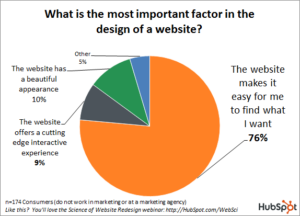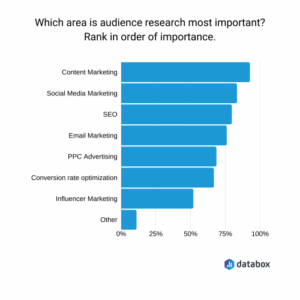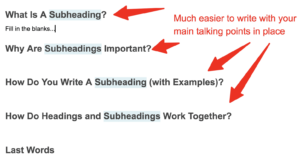In the fast-paced realm of online presence, envision a scenario where your website not only captures attention but emerges as a digital powerhouse through meticulously crafted content.
Picture a future where your words seamlessly resonate with your audience, driving unparalleled engagement and propelling your website to the zenith of search engine rankings.
Nowadays, having an online presence is a must for both companies and individuals. However, more than simply having a website is required. To capture your audience’s attention and express your brand’s message, you need to have the highest quality content on your website.

Let’s dive into the rules of website content writing: from tips to crafting engaging copy that resonates with readers and gets them to take action!
Table Of Content:
- Identify Your Target Audience
- Keyword Research: The Foundation of SEO
- Keep Your Content Simple and Clear
- Use Headings and Subheadings
- Keep Your Content Relevant and Up to Date
- Edit and Proofread Your Content
- Social Media Integration To Amplify Your Reach
- Conclusion
1. Identify Your Target Audience

To commence the process of drafting website content, it is of paramount importance to ascertain your intended recipients. Whom do you want to address? What are their areas of interest, sources of discomfort, and demands? Only upon comprehending the identity of your intended audience can you tailor your website content to engage them directly.
Utilize tools such as Google Analytics and social media insights to gather valuable data. Regularly update your buyer personas based on changing trends and customer feedback.
For example, suppose your target audience is college students. What difficulties does the student have? Many students have asked, “Where can I find a website that will write a paper for me?” Suppose one were to consider the matter at hand. In that case, the content on your website should be centred on the advantages of availing oneself of your paper and essay writing service, such as saving time and attaining superior grades. Alternatively, if your intended audience consists of professionals in the business realm, your website’s content should emphasize the significance of services that provide writing and editing assistance to maintain an image of professionalism.
Data from HubSpot’s survey indicates that companies updating their buyer personas regularly are 47% more successful in creating content that resonates with their audience. This emphasizes the importance of ongoing audience research for effective content creation.
2. Keyword Research: The Foundation of SEO

Keyword research forms the bedrock of any successful SEO service. Leverage tools like SEMrush or Ahrefs to identify relevant keywords in your niche. Develop a list of both primary and secondary keywords, strategically integrating them into your content.
A study by Backlinko highlights that pages using a target keyword in their URL tend to rank higher in Google. Ensuring your primary keyword is present in your URL can significantly impact your search rankings and visibility
The first organic search result on Google gets around 31.24% of clicks, highlighting the importance of getting the first position in Google search results. Therefore, it becomes important to do the keyword research effectively. ~ quote published on article cube
3. Keep Your Content Simple and Clear
When crafting website content, keep it brief and to the point. Steer clear of complex terminology that could confound your readers. Utilize uncomplicated and understandable words instead.
For website content readability, consider using the Flesch-Kincaid readability test. This test calculates a score based on the complexity of your writing, making it easy to check if your content is suitable for your target audience.
Utilize tools such as Google Analytics and social media insights to gather valuable data. Regularly update your buyer personas based on changing trends and customer feedback.
4. Use Headings and Subheadings
When examining your composed work, your spectators will navigate through your text with headings and subheadings, accentuating the most crucial particulars. These headings and subheadings augment your content’s visual allure and readability, consequently preserving the reader’s fascination with what you have to impart.
When creating headings and subheadings, it is vital to ensure they are brief and descriptive.

Use language that accurately reflects the section’s contents, and avoid using ambiguous or generic headings that offer no substantive information. To illustrate, it may be wise to use H1 titles for the primary sections of your website, H2 headings for subsections within those sections, and H3 headings for sub-subsections within those subsections. This strategy creates a well-defined information hierarchy and helps direct your audience through your content.
Lastly, keeping SEO in mind when crafting headings and subheadings is essential. To aid search engines in comprehending your website’s substance and enhance its ranking, it is crucial to incorporate relevant keywords in your titles and subheadings.
Data from HubSpot’s survey indicates that companies updating their buyer personas regularly are 47% more successful in creating content that resonates with their audience. This emphasizes the importance of ongoing audience research for effective content creation.
5. Keep Your Content Relevant and Up-to-Date

Maintaining the relevance and currency of website content is of utmost importance as the digital landscape continues to evolve. It not only captivates and retains your audience’s attention but also elevates your search engine rankings, as search engines place great emphasis on newly minted and pertinent material.
One strategy to ensure the timeliness of website content is to introduce new content frequently. These could be recent blog posts or articles highlighting your industry’s latest business trends, news, and insights. By staying up-to-date on the latest advancements in your field and sharing them with your audience, you can establish yourself as a competent authority and keep your website content stimulating.
6. Edit and Proofread Your Content

After spending considerable time creating and developing your website content, it may be tempting to be self-assured that all is well. Nonetheless, it would be best to devote ample time to revising and scrutinizing your content before publication.
Perusing your content will allow for identifying flaws or disparities that may taint your website’s calibre. Grammar, spelling, or incorrect sentence structure errors could detract from your audience’s experience, undermining their perception of your website’s professionalism. Therefore, investing significant time meticulously examining your website’s content before its release is fundamental.
Commence by meticulously combing each sentence and paragraph, painstakingly evaluating each text aspect. This systematic approach will help you eliminate any grammar, typos, or awkward phrasing errors that could compromise the quality of your website’s content.
Consider hiring a second pair of eyes to help edit and proofread the information on your website in addition to checking it yourself. Having someone with knowledge in your sector analyze your work can be advantageous because they can frequently spot problems or flaws you may have overlooked. To further ensure the quality of your content, consider using online proofreading and editing tools. Tools like Grammarly can help to identify and correct common grammatical errors, spelling mistakes, and other issues that can affect the quality of your content.
7. Social Media Integration to Amplify Your Reach

Extend the reach of your content by incorporating social media sharing buttons. Encourage readers to share your content, boosting its visibility and potential for higher search rankings.
Social media plays a pivotal role in content distribution. By making your content easily shareable, you tap into the vast potential of social networks, increasing your content’s reach and potential impact on search engine rankings.
Conclusion
Developing unique website content is paramount in maintaining your audience’s attention and elevating your website’s professional image. To accomplish this task, it is critical to adhere closely to the guidelines in this piece. Doing so will allow you to craft informative and captivating content, ultimately enabling you to achieve your objectives effectively.
It is crucial to bear in mind that the written composition presented on your online platform embodies your brand and carries the potential to exert a substantial impact on your audience’s perception of you. Therefore, you must allocate ample time and exert sufficient effort toward formulating top-tier content that effectively captivates your audience.

